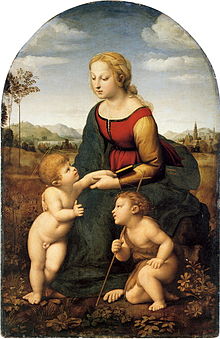Unione
This article provides insufficient context for those unfamiliar with the subject. (January 2019) |

According to the theory of the art historian Marcia B. Hall, which has gained considerable acceptance, unione (Italian: [uˈnjoːne]) is one of the canonical painting modes of the Renaissance; that is, one of four modes of painting colours available to Italian High Renaissance painters,[1][2] along with sfumato, chiaroscuro and cangiante.[3] Unione was developed by Raphael, who exemplified it in the Stanza della Segnatura.[4]
Unione is similar to sfumato, but is more useful for the edges of chiaroscuro, where vibrant colors are involved. As with chiaroscuro, unione conveys the contrasts, and as sfumato it strives for harmony and unity, but also for coloristic richness.[5] Unione is softer than chiaroscuro in the search for the right tonal key. There should be the harmony between light and dark, without the excesses and accentuation of a chiaroscuro mode.[6]
References
[edit]- ^ Hall, Marcia B., Rome (series "Artistic Centers of the Italian Renaissance"), pp. 148–150, 2005, Cambridge University Press, 2005, ISBN 0521624452, 9780521624459, google books
- ^ "Four Canonical Painting Modes by APA".. Retrieved June 18, 2015.
- ^ Hall, Marcia B. (1994). Color and Meaning: Practice and Theory in Renaissance Painting. New York: Cambridge University Press. ISBN 978-0-521-45733-0.
- ^ Hall, Marcia B., Rome (series "Artistic Centers of the Italian Renaissance"), pp. 148–150, Cambridge University Press, 2005, ISBN 0521624452, 9780521624459, Google Books
- ^ Hall, Marcia B. (1987). Color and Technique in Renaissance Painting: Italy and the North. J. J. Augustin.
- ^ Monteiro, Maria do Rosário; Kong, Mário S. Ming; Neto, Maria João Pereira (2016-11-03). Utopia(s) - Worlds and Frontiers of the Imaginary: Proceedings of the 2nd International Multidisciplinary Congress, October 20–22, 2016, Lisbon, Portugal. CRC Press. ISBN 9781351966832.
